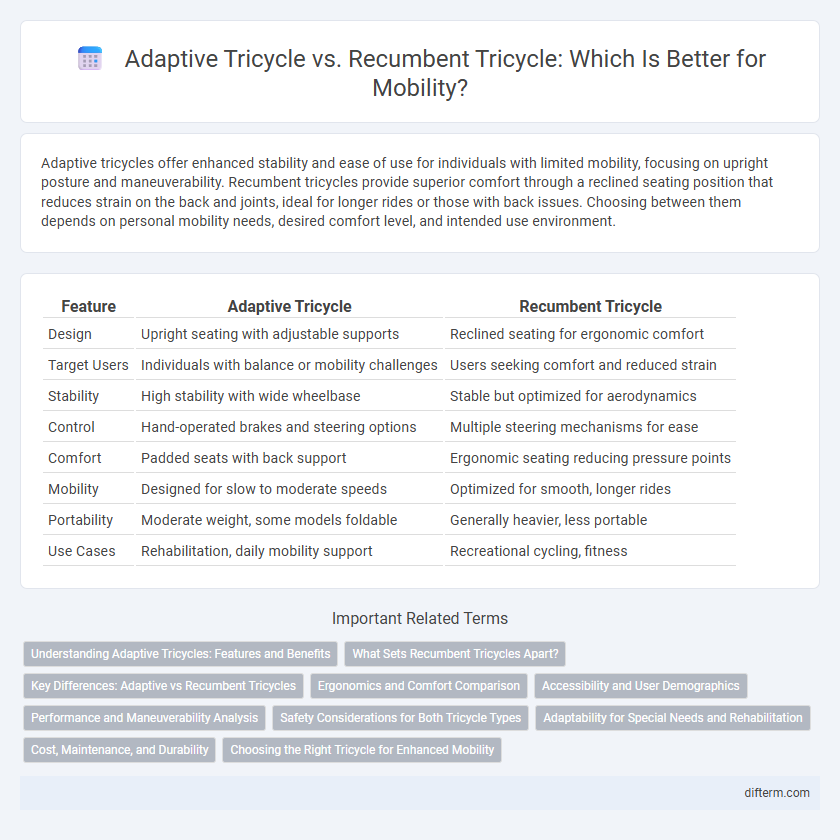Adaptive tricycles offer enhanced stability and ease of use for individuals with limited mobility, focusing on upright posture and maneuverability. Recumbent tricycles provide superior comfort through a reclined seating position that reduces strain on the back and joints, ideal for longer rides or those with back issues. Choosing between them depends on personal mobility needs, desired comfort level, and intended use environment.
Table of Comparison
| Feature | Adaptive Tricycle | Recumbent Tricycle |
|---|---|---|
| Design | Upright seating with adjustable supports | Reclined seating for ergonomic comfort |
| Target Users | Individuals with balance or mobility challenges | Users seeking comfort and reduced strain |
| Stability | High stability with wide wheelbase | Stable but optimized for aerodynamics |
| Control | Hand-operated brakes and steering options | Multiple steering mechanisms for ease |
| Comfort | Padded seats with back support | Ergonomic seating reducing pressure points |
| Mobility | Designed for slow to moderate speeds | Optimized for smooth, longer rides |
| Portability | Moderate weight, some models foldable | Generally heavier, less portable |
| Use Cases | Rehabilitation, daily mobility support | Recreational cycling, fitness |
Understanding Adaptive Tricycles: Features and Benefits
Adaptive tricycles offer enhanced stability and support through customizable seating and adjustable frame options, making them ideal for individuals with varying mobility needs. Unlike recumbent tricycles, which prioritize reclined seating for aerodynamics and comfort, adaptive tricycles emphasize accessibility and ease of use, featuring wider seats, supportive harnesses, and hand or foot propulsion varieties. These features promote improved balance, reduced fatigue, and increased independence for riders with physical limitations or rehabilitation needs.
What Sets Recumbent Tricycles Apart?
Recumbent tricycles feature a reclined seating position that distributes weight evenly, enhancing comfort and reducing strain on the back and wrists compared to adaptive tricycles. Their aerodynamic design improves speed and stability, making them ideal for longer rides and varied terrains. Advanced models often include adjustable seating and ergonomic controls, optimizing mobility for users with diverse physical abilities.
Key Differences: Adaptive vs Recumbent Tricycles
Adaptive tricycles feature customizable seating and support systems designed to accommodate users with limited mobility or balance issues, prioritizing stability and ease of use. Recumbent tricycles offer a reclined seating position that distributes weight evenly, enhancing comfort and reducing strain on the rider's back and joints. While adaptive tricycles focus on accessibility and support, recumbent models emphasize ergonomic design and performance for longer rides.
Ergonomics and Comfort Comparison
Adaptive tricycles offer enhanced ergonomic features such as adjustable seating positions and customizable pedal setups, promoting better posture and reducing strain during prolonged use. Recumbent tricycles focus on reclined seating that distributes body weight evenly, minimizing pressure points and enhancing comfort for long rides. Both designs prioritize rider comfort but differ in approach: adaptive tricycles cater to diverse mobility needs with versatile adjustments, while recumbent tricycles emphasize spinal support and aerodynamic posture.
Accessibility and User Demographics
Adaptive tricycles offer enhanced accessibility for users with limited balance or lower body strength, making them ideal for elderly individuals or those undergoing rehabilitation. Recumbent tricycles, designed with a reclined seating position, appeal to users seeking comfort and ergonomic support, particularly athletes and long-distance riders. User demographics for adaptive tricycles skew toward individuals with mobility impairments, while recumbent tricycles attract fitness enthusiasts and those with back issues.
Performance and Maneuverability Analysis
Adaptive tricycles offer enhanced maneuverability in tight spaces due to their compact design and lower center of gravity, making them ideal for urban mobility. Recumbent tricycles, while generally larger, provide superior performance on long distances with increased stability and reduced rider fatigue owing to their ergonomic seating position. Both types balance performance and maneuverability differently, with adaptive models excelling in agility and recumbent models optimizing sustained speed and comfort.
Safety Considerations for Both Tricycle Types
Adaptive tricycles and recumbent tricycles each offer unique safety features tailored to different mobility needs. Adaptive tricycles typically provide enhanced stability with wider wheelbases and customizable seating for balance, reducing the risk of falls. Recumbent tricycles emphasize ergonomic design and lower center of gravity, improving rider stability and minimizing strain during long rides, which contributes to overall safer handling.
Adaptability for Special Needs and Rehabilitation
Adaptive tricycles offer customizable seating and support features tailored to individuals with varying physical disabilities, enhancing stability and safety during mobility. Recumbent tricycles provide a low-impact, ergonomic position that reduces strain on joints, benefiting those undergoing rehabilitation or with limited mobility. Choosing between the two depends on specific therapeutic goals and user comfort, with both designs fostering independence and improved mobility outcomes.
Cost, Maintenance, and Durability
Adaptive tricycles generally cost less upfront compared to recumbent tricycles, making them a budget-friendly option for mobility solutions. Maintenance for adaptive tricycles tends to be simpler due to their straightforward design, whereas recumbent tricycles require more specialized care for components like reclining seats and advanced gearing systems. Durability is often higher in recumbent tricycles because of their robust construction and ergonomic support, which can better withstand long-term use and varied terrains.
Choosing the Right Tricycle for Enhanced Mobility
Adaptive tricycles offer customizable support and stability for users with varying mobility needs, making them ideal for rehabilitation and everyday transportation. Recumbent tricycles prioritize ergonomic seating and aerodynamic design, reducing strain on joints and enhancing comfort for long-distance rides. Selecting the right tricycle depends on individual mobility goals, physical condition, and terrain preferences to maximize both safety and independence.
adaptive tricycle vs recumbent tricycle Infographic

 difterm.com
difterm.com